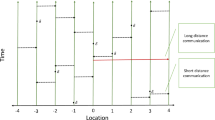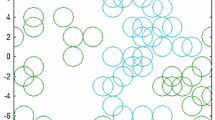Abstract
In attempt to reproduce and investigate nonlinear dynamics of financial markets, a new random agent-based financial price dynamics is developed and investigated by stochastic exclusion process. The exclusion process, one of Markov interacting processes, is firstly introduced to imitate the trading interactions among the investing agents in this work and to explain various statistical facts found in financial data. To better understand the fluctuation complexity properties of the proposed model, the complex analyses of random logarithmic price return series are preformed, including power-law distribution, Lempel–Ziv complexity, correlation dimension analysis, maximum Lyapunov exponent, mean Lyapunov exponents and Kolmogorov–Sinai entropy density. In order to verify the rationality of the model, the corresponding analyses of real return series are also studied for comparison. The empirical research reveals that this financial model can reproduce similar statistical behaviors, power-law distribution of returns, complexity and chaotic features of returns for real stock markets.







Similar content being viewed by others
References
Black, F., Scholes, M.: The pricing of options and corporate liabilities. J. Polit. Econ. 81, 637–654 (1973)
Calvet, L., Fisher, A.: Multifractal Volatility: Theory, Forecasting, and Pricing. Academic Press, New York (2008)
Duarte, F.B., Machado, J.A.T., Duarte, G.M.: Dynamics of the Dow Jones and the NASDAQ stock indexes. Nonlinear Dyn. 61, 691–705 (2010)
Elliott, R.J., Siu, T.K., Fung, E.S.: Filtering a nonlinear stochastic volatility model. Nonlinear Dyn. 67, 1295–1313 (2012)
Lux, T.: Financial Power Laws: Empirical Evidence, Models and Mechanisms. Cambridge University Press, Cambridge (2008)
Machado, J.A.T.: Complex dynamics of financial indices. Nonlinear Dyn. 74, 287–296 (2013)
Machado, J.A.T., Duarte, F.B., Duarte, G.M.: Analysis of financial data series using fractional Fourier transform and multidimensional scaling. Nonlinear Dyn. 65, 235–245 (2011)
Mantegna, R.N., Stanley, H.E.: An Introduction to Econophysics: Correlations and Complexity in Finance. Cambridge University Press, Cambridge (1999)
Gaylord, R., Wellin, P.: Computer Simulations with Mathematica: Explorations in the Physical, Biological and Social Science. Springer, New York (1995)
Ilinski, K.: Physics of Finance, Gauge Modeling in Nonequilibrium Pricing. Wiley, New York (2001)
Liu, F.J., Wang, J.: Fluctuation prediction of stock market index by Legendre neural network with random time strength function. Neurocomputing 83, 12–21 (2012)
Mills, T.C.: The Econometric Modeling of Financial Time Series, 2nd edn. Cambridge University Press, Cambridge (1999)
Ross, S.M.: An Introduction to Mathematical Finance. Cambridge University Press, Cambridge (1999)
Tavares, A.B., Curto, J.D., Tavares, G.N.: Modelling heavy tails and asymmetry using ARCH-type models with stable Paretian distributions. Nonlinear Dyn. 51, 231–243 (2008)
Lux, T., Marchesi, M.: Scaling and criticality in a stochastic multi-agent model of a financial market. Nature 397, 498–500 (1999)
Yu, Y., Wang, J.: Lattice-oriented percolation system applied to volatility behavior of stock market. J. Appl. Stat. 39, 785–797 (2012)
Yang, G., Wang, J., Fang, W.: Numerical analysis for finite-range multitype stochastic contact financial market dynamic systems. Chaos 25, 043111 (2015)
Fang, W., Wang, J.: Fluctuation behaviors of financial time series by a stochastic Ising system on a Sierpinski carpet lattice. Phys. A 392, 4055–4063 (2013)
Niu, H.L., Wang, J.: Complex dynamic behaviors of oriented percolation-based financial time series and Hang Seng index. Chaos Solitons Fractals 52, 36–44 (2013)
Stauffer, D., Penna, T.J.P.: Crossover in the Cont-Bouchaud percolation model for market fluctuation. Phys. A 256, 284–290 (1998)
Yang, G., Chen, Y., Huang, J.P.: The highly intelligent virtual agents for modeling financial markets. Phys. A 443, 98–108 (2016)
Shang, Y.: An agent based model for opinion dynamics with random confidence threshold. Commun. Nonlinear Sci. 19, 3766–3777 (2014)
Li, R., Wang, J.: Interacting price model and fluctuation behavior analysis from Lempel–Ziv complexity and multi-scale weighted-permutation entropy. Phys. Lett. A 380, 117–129 (2016)
Vladimirov, S.N.: Probabilistic method of calculating the Maximum Lyapunov Exponent for motion of chaotic systems. Russ. Phys. J. 48, 660–663 (2005)
Awrejcewicz, J., Krysko, V.A., Kutepov, I.E., Vygodchikova, I.Y., Krysko, A.V.: Quantifying chaos of curvilinear beams via exponents. Commun. Nonlinear Sci. 27, 81–92 (2015)
Piqueira, J.R.C., Mortoza, L.P.D.: Brazilian exchange rate complexity: financial crisis effects. Commun. Nonlinear Sci. 17, 1690–1695 (2012)
Zhang, Y.Q., Wang, X.Y.: A new image encryption algorithm based on non-adjacent coupled map lattices. Appl. Soft Comput. 26, 10–20 (2015)
Zhang, Y.Q., Wang, X.Y.: A symmetric image encryption algorithm based on mixed linear-nonlinear coupled map lattice. Inf. Sci. 273, 329–351 (2014)
Zhang, Y.Q., Wang, X.Y.: Spatiotemporal chaos in mixed linearCnonlinear coupled logistic map lattice. Phys. A 402, 104–118 (2014)
Gerodimos, N.A., Daltzis, P.A., Hanias, M.P., Nistazakis, H.E., Tombras, G.S.: Experimental and Simulated Chaotic RLD Circuit Analysis with the Use of Lorenz Maps. Springer, Berlin (2013)
Niu, H.L., Wang, J.: Quantifying complexity of financial short-term time series by composite multiscale entropy measure. Commun. Nonlinear Sci. 22, 375–382 (2015)
Wolf, A., Swift, J.B., Swinney, H.L., Vastano, J.A.: Determining Lyapunov exponents from a time series. Phys. D 16, 285–317 (1985)
Liggett, T.M.: Interacting Particle Systems. Springer, New York (1985)
Liggett, T.M.: Stochastic Interacting Systems: Contact, Voter and Exclusion Processes. Springer, New York (1999)
Sopasakis, A., Katsoulakis, M.A.: Stochastic modeling and simulation of traffic flow: asymmetric single exclusion process with arrhenius look-ahead dynamics. SIAM J. Appl. Math. 66, 921–944 (2006)
Gray, L., Griffeath, D.: The ergodic theory of traffic jams. J. Stat. Phys. 105, 413–452 (2001)
Lempel, A., Ziv, J.: On the complexity of finite sequences. IEEE Trans. Inf. Theory IT 22, 75–81 (1976)
Fernández, A., López-Ibor, M., Turrero, A., Santos, J., Morón, M., Hornero, R., Gómez, C., Méndez, M.A., Ortiz, T., López-lbor, J.J.: Lempel–Ziv complexity in shizophrenia: a MEG study. Clin. Neurophysiol. 122, 2227–2235 (2011)
Abásolo, D., Hornero, R., Gómez, C., García, M., López, M.: Analysis of EEG background activity in Alzheimer’s disease patients with Lempel–Ziv complexity and central tendency measure. Med. Eng. Phys. 28, 315–322 (2006)
Hong, H., Liang, M.: Fault severity assessment for rolling element bearings using the Lempel–Ziv complexity and continuous wavelet transform. J. Sound Vib. 320, 452–468 (2009)
Tang, J., Wang, Y., Wang, H., Zhang, S., Liu, F.: Dynamic analysis of traffic time series at different temporal scales: a complex networks approach. Phys. A 405, 303–315 (2014)
Zhang, X.S., Roy, R.J., Jensen, E.W.: EEG complexity as a measure of depth of anesthesia for patients. IEEE Trans. Biomed. Eng. 48, 1424–1433 (2001)
Yan, R., Gao, R.X.: Complexity as a measure for machine health evaluation. IEEE Trans. Instrum. Measu. 53, 1327–1334 (2004)
Wu, X., Xu, J.: Complexity and brain function. Acta Biophys. Sin. 7, 103–106 (1991)
Yilmaz, D., Gler, N.F.: Analysis of the Doppler signals using largest Lyapunov exponent and correlation dimension in healthy and stenosed internal carotid artery patients. Digit. Signal Process. 20, 401–409 (2010)
Takens, F.: Detecting Strange Attractors in Turbulence. Springer, New York (1981)
Frazer, A.M., Swinney, H.L.: Independent coordinates for strange attractors from mutual information. Phys. Rev. A 33, 1134–1140 (1986)
Grassberger, P., Proccacia, I.: Measuring the strangeness of strange attractors. Phys. D 9, 189–208 (1983)
Rosenstein, M.T., Collins, J.J., DeLuca, C.J.: Apractical method for calculating largest Lyapunov exponents from small data sets. Phys. D 65, 117–134 (1993)
Brigham, E.O.: The Fast Fourier Transform. Prentice-hall Inc, Englewood (1974)
Shibata, H.: KS entropy and mean Lyapunov exponent for coupled map lattices. Phys. A 292, 182–192 (2001)
Acknowledgements
The authors were supported in part by National Natural Science Foundation of China Grant No. 71271026.
Author information
Authors and Affiliations
Corresponding author
Rights and permissions
About this article
Cite this article
Zhang, W., Wang, J. Nonlinear stochastic exclusion financial dynamics modeling and complexity behaviors. Nonlinear Dyn 88, 921–935 (2017). https://doi.org/10.1007/s11071-016-3285-0
Received:
Accepted:
Published:
Issue Date:
DOI: https://doi.org/10.1007/s11071-016-3285-0




